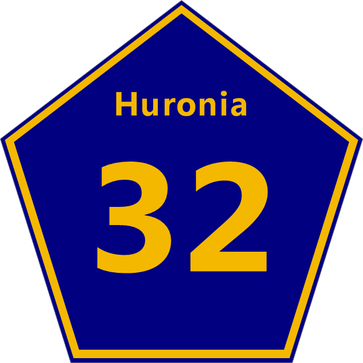I recently rediscovered a highway sign that Lord Grattan made for this TL. Not to let it go to waste, I've written up a basic history of Huronia to accompany it:
Historically, Huronia was the core territory of the Huron-Petun or Wendat Confederacy, a strong agricultural nation that controlled much of the land between Canada, Ohio, and the Upper Country. Disease and war with the Iroquois weakened the confederation, and the more outlying members drifted off, later to form new confederacies important in the early history of Ohio. By the late 17th century the confederation was nearly defunct. Other groups moved in to the region, especially Anishinaabe peoples connected to the famous Council of Three Fires.
From this point and throughout the 18th century, the French continued to call the region Huronia and considered it a secure part of their zone of influence. Most of the villages in Huronia - Wendat, Anishinaabe, French, Mixed - were bound together in the Canadian alliance, and the people were generally loyal "Children of Onontio." Catholicism spread throughout the region. Toward the end of the century more permanent institutions of modern government were set up to help the growing villages manage their affairs and strengthen links with Canada. A complete working government separate from Canada was achieved only in 1820, after the rise of the ASB removed the threat of attacks from Iroquoia and the English. Full independence came later still.
Peace and a rising population during this time led to the rapid growth of ports throughout the Great Lakes. In Huronia, Toronto became the new economic center. A wave of immigrants arrived from New Netherland and Canada, greatly changing Huronia's ethnic mix. To this day, much of Toronto is Dutch-speaking, as are several other communities in southern Huronia. Seneca and other Iroquois arrived as well, seeking economic opportunity in the land of their former arch-enemies. While the capital of the state moved a few times in the early years, it was fixed at Toronto after 1824. Fed by Toronto and a growing export agricultural sector, Huronia became an economic powerhouse, and it remains so today.
No map yet, the only visual so far is this state highway sign. Route 32 is one of Huronia's principal roads. It runs from Toronto north to the Sea of Wendake (Georgian Bay in OTL), crossing the narrowest part of the state.

Historically, Huronia was the core territory of the Huron-Petun or Wendat Confederacy, a strong agricultural nation that controlled much of the land between Canada, Ohio, and the Upper Country. Disease and war with the Iroquois weakened the confederation, and the more outlying members drifted off, later to form new confederacies important in the early history of Ohio. By the late 17th century the confederation was nearly defunct. Other groups moved in to the region, especially Anishinaabe peoples connected to the famous Council of Three Fires.
From this point and throughout the 18th century, the French continued to call the region Huronia and considered it a secure part of their zone of influence. Most of the villages in Huronia - Wendat, Anishinaabe, French, Mixed - were bound together in the Canadian alliance, and the people were generally loyal "Children of Onontio." Catholicism spread throughout the region. Toward the end of the century more permanent institutions of modern government were set up to help the growing villages manage their affairs and strengthen links with Canada. A complete working government separate from Canada was achieved only in 1820, after the rise of the ASB removed the threat of attacks from Iroquoia and the English. Full independence came later still.
Peace and a rising population during this time led to the rapid growth of ports throughout the Great Lakes. In Huronia, Toronto became the new economic center. A wave of immigrants arrived from New Netherland and Canada, greatly changing Huronia's ethnic mix. To this day, much of Toronto is Dutch-speaking, as are several other communities in southern Huronia. Seneca and other Iroquois arrived as well, seeking economic opportunity in the land of their former arch-enemies. While the capital of the state moved a few times in the early years, it was fixed at Toronto after 1824. Fed by Toronto and a growing export agricultural sector, Huronia became an economic powerhouse, and it remains so today.
No map yet, the only visual so far is this state highway sign. Route 32 is one of Huronia's principal roads. It runs from Toronto north to the Sea of Wendake (Georgian Bay in OTL), crossing the narrowest part of the state.

Last edited: